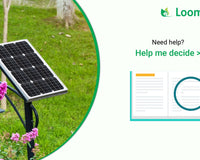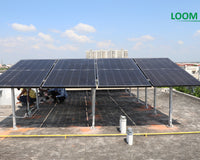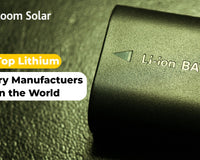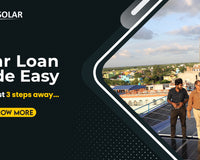As we are aware that summer season is ready to hit us and the Indian weather calls for a full-time supply of electricity, this leads to backing up of inverter batteries. The need is prevalent, so much so that almost 1 lac inverters are selling every year. Every inverter has 3 to 5 years of warranty and almost all normal inverters has turned obsolete in the Indian market.
Well, here is 2021 with the booming market of solar inverters to fulfill the power back-up facility in India. In this article, we will discuss about a step-by step upgradation of the existing solar power systems at your home into maximum capacity.
So, stay tuned to understand this easy and useful process that will change the face of India in the future!
The idea of a Solar Panel equipped home is relatively new. So, a person starts with a small system to test its capabilities and understand its performance. With performance, comes services, limitations and support of the product. Solar Panel System is the combination of solar panel, an inverter, a battery and the balancing of the system. When we choose solar power system, compatibility is the main key factor we’re looking for.
Let’s take an example here. A person entering the gadget market buys a phone according to his required features and budget. After he’s used to it and the features of the phone becomes dated, he upgrades to a new model and the cycle continues.

Similarly, upgrading from a small Loom Solar panel to a bigger one maximizes your capacity to meet the power needs in a home:

Here are few basic tips to follow in order to utilize the budget & existing system at your place.
| Year | Brand | Cost |
| 2018 | DC Light, Fans & Mobile Charging | 20W |
| 2019 | Lights, Fan, Mobile Charging | 100W |
| 2020 | Lights, Fan, Mobile Charging, Submersible Pump, Refrigerator, TV | 1700W |
| 2021 | Lights, Fan, Mobile Charging, Submersible Pump, Medical Clinic Equipment | 3500W |
Let’s understand the Functionality of the Inverter:
(The best inverter should have double the capacity of the load (watt) at your home.)
Any buyer should be aware of the power need in his home as the capacity of the Inverter (mentioned in the first column) should be double the requirement of the load of the appliances used at their home.
So, average homes with basic requirements like the functioning of fan and tube-lights can be fulfilled by the 300Watt inverter and thus would require a 400VA inverter.
The table below explains the need of different households and the different inverter options for your reference,
|
Capacity (kW) |
Nominal Output Current (A) |
Load (A) |
Load (Watt) |
Cost (Rs.) |
|
400VA Inverter |
- |
1.45 |
300 |
4,800 |
|
700VA Inverter |
- |
2.54 |
560 |
6,000 |
|
1135VA Inverter |
- |
4.12 |
908 |
6,300 |
|
1735VA Inverter |
- |
6.30 |
1388 |
8,100 |
|
2335VA Inverter |
- |
8.40 |
1868 |
8,300 |
|
1KW PCU |
4.3 |
1.3 |
300 |
16,000 |
|
2KW PCU |
8.5 |
2.7 |
1000 |
38,000 |
|
3KW PCU |
13 |
12 |
1700 |
40,000 |
|
6KW PCU |
26 |
10 |
2500 |
75,000 |
|
7.5KW PCU |
33 |
15 |
3500 |
115,000 |
|
10KW PCU |
44 |
Future Expendable |
|
135,000 |
The cost per inverter will vary, depending upon the brands. The cost of a premium brand inverter will approximately be double the amount of the local inverter manufactured. Before buying, one must research the price of different inverter companies here, with us.
Let’s also understand the functioning of the Battery

Most inverters support a battery power of 80Ah to 200Ah. Now, an 80Ah battery can give 768 watts of storage capacity and give a backup of almost 3 hours and this multiplies when the battery power increases.
- Every inverter supports 100Ah to 200Ah Battery.
- A 400VA to 1135VA Inverter supports Single Battery (12V),
- A 1735VA to 2500VA Inverter supports Double Battery (12V*2=24V)
- A 1KW PCU supports 24V Battery,
- A 2KW & 3KW PCU support 48V Battery (12V*4),
- A 6KW PCU supports 96V Battery (12V*8)
- A 7.5KW PCU supports 120V Battery (12V*10)
- And a 10KW PCU supports 120V Battery (12V*10)
Let’s understand Solar Panel

Now, every inverter has a synchronization power with a solar panel and the voltage and the current of the inverter should be between the notations given below and if the inverter gives less than the numberings given below, then the solar panel would show “low voltage”.
And the Maximum amp of solar panel should not be more than inverter charge controller rating and VoC of the solar panel should not show more than charge controller VoC. Otherwise, inverter / charge controller will be show “over voltage”. The panel should show ideal condition with correct combinations of voltage and current of the inverter. These are given below for your reference.
Inverter Charge Controller Options

Luminous solar nxg + hybrid inverter 750 - 12V – 20 Amp/12V – 19V to 25V
Luminous Solar nxg hybrid Inverter 1100 - 12V – 40 Amp/12V – 19V to 25V
Microtek Solar Inverter msun 1235 Off Grid – 30 Amp/12V – NA
On the basis of inverter charge controller, one can decide the solar panel wattage and capacity.
On the basis of above calculation, you can also upgrade your solar system very easily.
Existing Solar Power System – Off Grid Solar System
10W – 50W
50W – 180W
180W – 375W
500W – 1000W (1KW)
1KW – 3KW
3KW – 7KW
7KW – 10KW
Conclusion
Still confused? Worry not, as the Loom Solar is here at your service to create the best consumer experience and the right choice for your home. We are a one-stop destination for a perfect rooftop solar panel installation experience and we take pride in announcing that we’ve hit half a century already by installing 50,000 panels with the help of our solar experts in across India.












